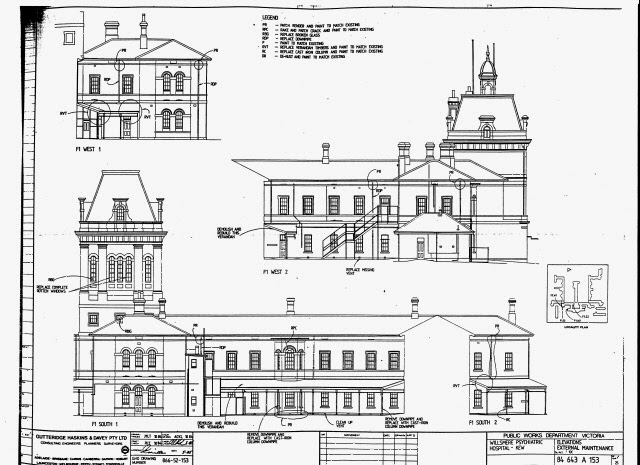. . .
Clue 1 - Changing traditions, changing skyline, some things stay the same.
The foreground buildings are typical examples
of the French Second Empire style which was popular in Victorian Melbourne.
The walls of these buildings contain a history some would rather forget.
PUZZLE
REVEALED
Kew Idiot Asylym / Kew Cottages / Wilsmere Hospital / Yarra Bend Lunatic Asylum
The collection of buildings on the Kew hill have gone by many names,
some of which directly allude to its history.
When it opened in 1887, the Kew Asylum was intended to be 'an institution for the care and training of the feeble-minded children'. Its owners hoped the institution would train patients for 'lives of usefulness'. Such hopes were, however, only one reason why families decided to commit their children to the Asylum, as requests for admission to the institution reveal.
The former Willsmere Hospital, previously know as the Kew Lunatic Asylum, was commenced in 1856 and opened in 1872. The design of the complex was based on contemporary English models of asylum planning. The E-shaped complex of buildings was designed in the Italianate style by various architects employed by the Victorian Public Works Department. The central administration block comprises a three-storeyed building with attic Mansard roof and cupola, with two double-storeyed wings extending to each side which include a four-storey Mansard roofed tower, and courtyards lined with iron columned verandahs. The complex was set in a garden and surrounded by a walled fence. Fever Tents were erected in 1907 in response to a major typhoid epidemic.
"Three cottages, a schoolroom and a kitchen &c., were erected at a short distance from the main building of Kew, and opened as an institution of the feeble-minded children on the 19th May, 1887. ...I am glad to be able to report that the work is being carried out in a fairly satisfactory manner, and signs of improvement can be noticed in the children. The school work has been well started, but no arrangements have been made for teaching trades or handicrafts".
James V McCreerey, Medical Superintendent, Kew Lunatic Asylum in Request of Inspector of Asylums on the Hospitals for the Insane, Victoria. Papers Presented to Parliament, 1888, Vol. III,46
By 1897 there were 203 residents in the institution's cottages and overcrowding saw living conditions deteriorate, particularly during the severe economic depression of the 1890's.
While some in the community feared people with intellectual disability and agitated for their confinement, others gave their time to brighten the patients' lives. However, the few hard-pressed staff struggled to adequately care for the patients.
A severe typhoid epidemic swept the Asylum in 1907, causing deaths of patients and staff.The school rooms were turned into makeshift isolation wards and lessons suspended.
Optimism about the potential of people with intellectual disability was replaced by the fear that they were 'a menace to the future of the Australian people' and should be permanently confined to institutions to protect the community. The year was 1912.
The institution continued to function. The problems grew and funding did not.
A shed down the hill by the bitumen where they go when it rains is a cage out of a very old zoo where young men charged with psychosis charge up and down and round and round like angry old bears in a pit. All is lost in these quarters. They stamp the place as a village of the damned. Yes, surely such sights and sounds belong to another planet. Kew is this."[The Age, 1973]
The history of the treatment of mental health by the Victorian Government and indeed by state governments across Australia has been deplorable and Dickensian. Then after the David Richmond Report of 1983 found systematic institutional abuse of patients and recommended moving people out of psychiatric wards to be cared for in the community, 'deinstitutionalisation', has simply replaced abuse with abandonment and land-speculation with ideology.
This appalling situation came to a tragic head in 1996 when 9 young patients tragically died in a fire because the cottages did not contain basic fire fighting equipment or sprinklers.
While the Victorian Government may have ripped down the long high brick wall around Kew Cottages to open it up to the community for housing, it has retained a shroud of avoidance around the mental health problem in our society.
The Victorian Government has illegitimately profited from its decades of neglect of mental health responsibilities and then has profited from selling public land set aside for mental health care. It has immorally encouraged new investors in Kew Cottages to effectively displace our mentally ill, many of whom now have nowhere to go.
Research:
Freewebs
Kewcottagehistory
Kew archives
Wikipedia
Cameron Rose
This page was last updated January 27, 2014
This page was last edited 13/01/2014













No comments:
Post a Comment